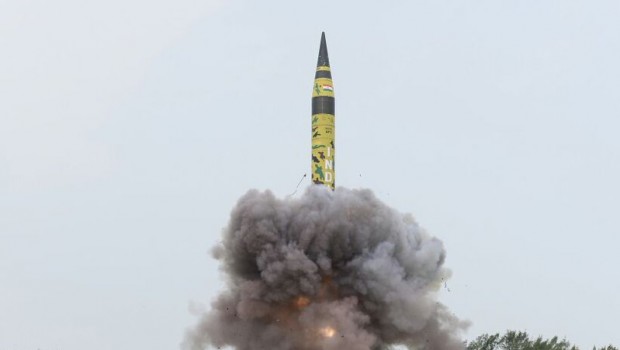A new nuclear arms race has begun and it does not revolve around the number of weapons, but on increasing their deadliness. Recent nuclear missile tests by India and Russia show that nuclear-armed states are blatantly flaunting their nuclear power, posturing as tough and responsible “protectors” while in reality they put the world at large at risk.
In contrast to the Cold War arms race, when the Soviet Union and United States produced tens of thousands of nuclear warheads to match each other’s “overkill capacity”, the new nuclear arms race centres on the qualitative refinement of nuclear capabilities. Nuclear-armed states keep pouring money into their nuclear-weapon programmes. While the number of banks and financial institutions investing in nuclear weapons technology appears to be declining, the overall volume of investment in nuclear weapons is on the rise.
Two nuclear missile tests in less than two weeks
Holy cow’ski! Video of Russian quadruple Bulava (SS-N-32) SLBM launch from Borei SSBN. https://t.co/ICJgfk0sD8 h/t @KomissarWhipla
4 launched in 20 seconds. All 16 could launch in ~1 minute.
4 SLBM can deliver total of 24 MIRV warheads with 2,400 kilotons = 160 Hiroshimas. pic.twitter.com/iFy585yfPg
— Hans Kristensen (@nukestrat) May 23, 2018
Two recent events illustrate the dynamics of this new arms race:
First, on 22 May, Russia test-fired four long-range ballistic missiles capable of carrying 24 nuclear warheads. Together, the four missiles could deliver an explosion 160 times that of the bomb that devastated Hiroshima in 1945. The blast, firestorms, and radiation caused by the Hiroshima bomb is estimated to have killed almost 200,000 people , a number that may still be rising, as radiation-induced cancer remains disproportionately prevalent among survivors.
Second, on 3 June, India test-fired its Agni-V missile from a missile base in Hyderabad. Agni-V is a long-range nuclear missile capable of hitting most of Asia, Africa, and Europe.
The attitudes from both states in regard to these tests are both telling and alarming: The Russian Ministry of Defence released a promo video of the missile tests showing a Russian submarine firing off the four missiles from a submerged position in the White Sea. In India, the test was celebrated by the Indian government and media. India – a champion of nuclear disarmament during much of the Cold War – reversed its position in the 1990s and has gradually built up its nuclear arsenal. Former Indian governments’ former position – that nuclear weapons are unacceptable weapons of mass destruction designed to slaughter civilians – no longer holds sway in New Delhi.
Long range ballistic missile Agni 5 was successfully flight tested at 0945 hrs today from Dr APJ Abdul Kalam Island (Wheeler Island). Smt @nsitharaman congratulates @DRDO_India , the armed forces & defence industry for the success of the A5 mission. https://t.co/mHG519lgQG pic.twitter.com/XKkpomR3q1
— Raksha Mantri (@DefenceMinIndia) June 3, 2018
Reactions around the world: Where’s the outrage?
Perhaps equally troubling, the international community is failing to loudly condemn India and Russia for these nuclear missile tests. Instead of delivering harsh criticism, states have responded with deafening silence or worse: a renewed focus on rearmament.
Russia’s bellicose stance in recent years has resulted in considerable rearmament in Eastern Europe and the Nordic region. Polish politicians have even played with the idea of inviting the United States to station nuclear weapons on Polish territory. The United States is already spending huge money on “modernizing” its nuclear force, including the B-61 nuclear bombs it stations in Belgium, Germany, Italy, the Netherlands, and Turkey.
India’s nuclear missile development also creates incentives – or perhaps a pretext – for other states to develop similar arms. India’s nuclear expansion is itself a response to developments in the region. Last year, Pakistan reportedly became the first state in South Asia to develop missiles with multiple independently targeted re-entry vehicles (MIRVs), that is, missiles capable of delivering several nuclear warheads.
Time to stigmatize nuclear weapons and join the nuclear ban treaty
In contrast to banned chemical and biological weapons, which are widely regarded as immoral, recent events show that some states still consider nuclear weapons as legitimate and prestigious. From Moscow to New Delhi to Washington DC and Pyongyang, nuclear-armed leaders are using nuclear weapons to signal strength and resolve. But the majority of the world disagrees. On 7 July 2017, 122 states voted to adopt the Treaty on the Prohibition of Nuclear Weapons (TPNW), a landmark agreement prohibiting the development, possession, and use of nuclear weapons.
The TPNW is a perfect tool for the international community to de-legitimise and stigmatise nuclear weapons. By joining and promoting the treaty, states can create the same moral stigma around nuclear weapons as currently exists around chemical and biological arms. As long as the international community focuses its efforts on “irresponsible” nuclear behaviour such as proliferation, testing, or use, global nuclear disarmament will remain difficult to achieve. To achieve disarmament, the international community must de-legitimise nuclear weapons themselves. For responsible states, the way forwards is clear: sign and ratify the Treaty on the Prohibition of Nuclear Weapons!






